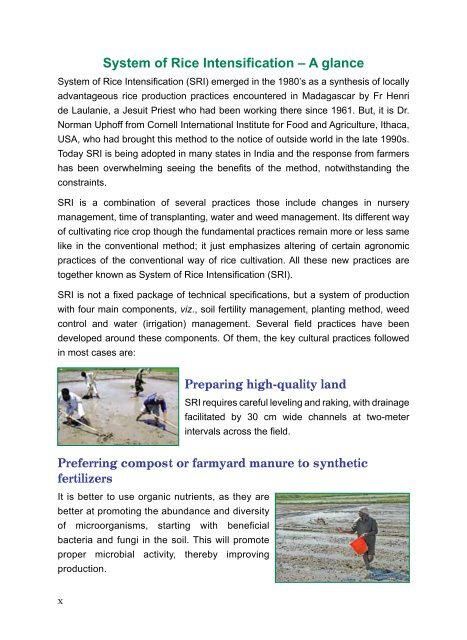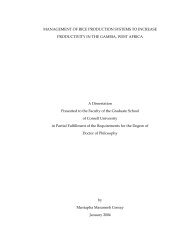Experiences of Farmers in India Experiences of Farmers in ... - AgSri
Experiences of Farmers in India Experiences of Farmers in ... - AgSri
Experiences of Farmers in India Experiences of Farmers in ... - AgSri
Create successful ePaper yourself
Turn your PDF publications into a flip-book with our unique Google optimized e-Paper software.
x<br />
System <strong>of</strong> Rice Intensification – A glance<br />
System <strong>of</strong> Rice Intensification (SRI) emerged <strong>in</strong> the 1980’s as a synthesis <strong>of</strong> locally<br />
advantageous rice production practices encountered <strong>in</strong> Madagascar by Fr Henri<br />
de Laulanie, a Jesuit Priest who had been work<strong>in</strong>g there s<strong>in</strong>ce 1961. But, it is Dr.<br />
Norman Uph<strong>of</strong>f from Cornell International Institute for Food and Agriculture, Ithaca,<br />
USA, who had brought this method to the notice <strong>of</strong> outside world <strong>in</strong> the late 1990s.<br />
Today SRI is be<strong>in</strong>g adopted <strong>in</strong> many states <strong>in</strong> <strong>India</strong> and the response from farmers<br />
has been overwhelm<strong>in</strong>g see<strong>in</strong>g the benefits <strong>of</strong> the method, notwithstand<strong>in</strong>g the<br />
constra<strong>in</strong>ts.<br />
SRI is a comb<strong>in</strong>ation <strong>of</strong> several practices those <strong>in</strong>clude changes <strong>in</strong> nursery<br />
management, time <strong>of</strong> transplant<strong>in</strong>g, water and weed management. Its different way<br />
<strong>of</strong> cultivat<strong>in</strong>g rice crop though the fundamental practices rema<strong>in</strong> more or less same<br />
like <strong>in</strong> the conventional method; it just emphasizes alter<strong>in</strong>g <strong>of</strong> certa<strong>in</strong> agronomic<br />
practices <strong>of</strong> the conventional way <strong>of</strong> rice cultivation. All these new practices are<br />
together known as System <strong>of</strong> Rice Intensification (SRI).<br />
SRI is not a fixed package <strong>of</strong> technical specifications, but a system <strong>of</strong> production<br />
with four ma<strong>in</strong> components, viz., soil fertility management, plant<strong>in</strong>g method, weed<br />
control and water (irrigation) management. Several field practices have been<br />
developed around these components. Of them, the key cultural practices followed<br />
<strong>in</strong> most cases are:<br />
Prepar<strong>in</strong>g high-quality land<br />
SRI requires careful level<strong>in</strong>g and rak<strong>in</strong>g, with dra<strong>in</strong>age<br />
facilitated by 30 cm wide channels at two-meter<br />
<strong>in</strong>tervals across the field.<br />
Preferr<strong>in</strong>g compost or farmyard manure to synthetic<br />
fertilizers<br />
It is better to use organic nutrients, as they are<br />
better at promot<strong>in</strong>g the abundance and diversity<br />
<strong>of</strong> microorganisms, start<strong>in</strong>g with beneficial<br />
bacteria and fungi <strong>in</strong> the soil. This will promote<br />
proper microbial activity, thereby improv<strong>in</strong>g<br />
production.
















